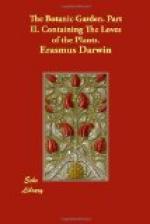B. In what then consists the essential difference between Poetry and Prose?
P. Next to the measure of the language, the principal distinction appears to me to consist in this: that Poetry admits of but few words expressive of very abstracted ideas, whereas Prose abounds with them. And as our ideas derived from visible objects are more distinct than those derived from the objects of our other senses, the words expressive of these ideas belonging to vision make up the principal part of poetic language. That is, the Poet writes principally to the eye, the Prose-writer uses more abstracted terms. Mr. Pope has written a bad verse in the Windsor Forest:
“And Kennet swift for silver Eels renown’d.”
The word renown’d does not present the idea of a visible object to the mind, and is thence prosaic. But change this line thus,
“And Kennet swift, where silver Graylings play.” and it becomes poetry, because the scenery is then brought before the eye.
B. This may be done in prose.
P. And when it is done in a single word, it animates the prose; so it is more agreeable to read in Mr. Gibbon’s History, “Germany was at this time over-shadowed with extensive forests;” than Germany was at this time full of extensive forests. But where this mode of expression occurs too frequently, the prose approaches to poetry: and in graver works, where we expect to be instructed rather than amused, it becomes tedious and impertinent. Some parts of Mr. Burke’s eloquent orations become intricate and enervated by superfluity of poetic ornament; which quantity of ornament would have been agreeable in a poem, where much ornament is expected.
B. Is then the office of poetry only to amuse?
P. The Muses are young ladies, we expect to see them dressed; though not like some modern beauties with so much gauze and feather, that “the Lady herself is the least part of her.” There are however didactic pieces of poetry, which are much admired, as the Georgics of Virgil, Mason’s English Garden, Hayley’s Epistles; nevertheless Science is best delivered in Prose, as its mode of reasoning is from stricter analogies than metaphors or similies.
B. Do not Personifications and Allegories distinguish poetry?
P. These are other arts of bringing objects before the eye; or of expressing sentiments in the language of vision; and are indeed better suited to the pen than the pencil.
B. That is strange, when you have just said they are used to bring their objects before the eye.
P. In poetry the personification or allegoric figure is generally indistinct, and therefore does not strike us as forcibly as to make us attend to its improbability; but in painting, the figures being all much more distinct, their improbability becomes apparent, and seizes our attention to it. Thus the person of Concealment is very indistinct and therefore does not compel us to attend to its improbability, in the following beautiful lines of Shakespear:




